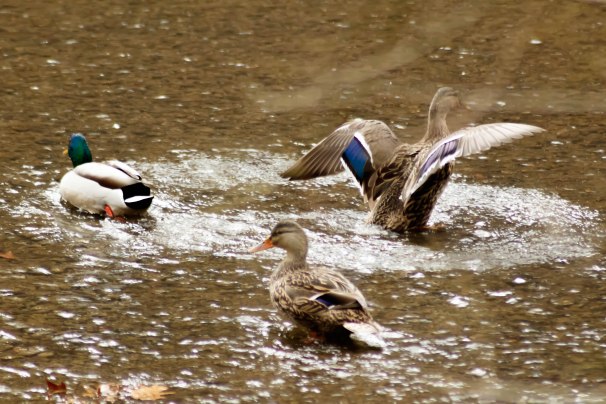The Mallard or Wild Duck (Anas platyrhynchos) is a dabbling duck which breeds throughout the temperate and subtropical Americas, Eurasia, and North Africa, and has been introduced to New Zealand, Australia, Peru, Brazil, Uruguay, Argentina, Chile, the Falkland Islands and South Africa. This duck belongs to the subfamily Anatinae of the waterfowl family Anatidae.
The male birds (drakes) have a glossy green head and are gray on wings and belly, while the females (hens or ducks) have mainly brown-speckled plumage. Both sexes have an area of white-bordered black speculum feathers which commonly also include iridescent blue feathers, especially among males. Mallards live in wetlands, eat water plants and small animals, and are social animals preferring to congregate in groups or flocks of varying sizes. This species is the main ancestor of most breeds of domesticated ducks. [Wikipedia]
If someone at a park is feeding bread to ducks, chances are there are Mallards in the fray. Perhaps the most familiar of all ducks, Mallards occur throughout North America and Eurasia in ponds and parks as well as wilder wetlands and estuaries. The male’s gleaming green head, gray flanks, and black tail-curl arguably make it the most easily identified duck. Mallards have long been hunted for the table, and almost all domestic ducks come from this species. [All About Birds]
Mallard Facts [All About Birds]
- Mallard pairs are generally monogamous, but paired males pursue females other than their mates. So-called “extra-pair copulations” are common among birds and in many species are consensual, but male Mallards often force these copulations, with several males chasing a single female and then mating with her.
- Mallard pairs form long before the spring breeding season. Pairing takes place in the fall, but courtship can be seen all winter. Only the female incubates the eggs and takes care of the ducklings.
- The standard duck’s quack is the sound of a female Mallard. Males don’t quack; they make a quieter, rasping sound.
- The oldest known Mallard was a male, and at least 27 years, 7 months old when he was shot in Arkansas in 2008. He had been banded in Louisiana in 1981.










I love how you really captured all the colors of the feathers in the pictures. I’ve never really noticed how many there were before.
LikeLiked by 1 person
Thank you, I never noticed before too. 🙂
LikeLiked by 1 person
You…mi Amigo are a natural @this…Wow! You were born to do this!!!!🌎🌍🌏
LikeLiked by 1 person
Thank you, I appreciate it. I am still learning. ☺
LikeLiked by 1 person
Sure🌐🌍
LikeLiked by 1 person